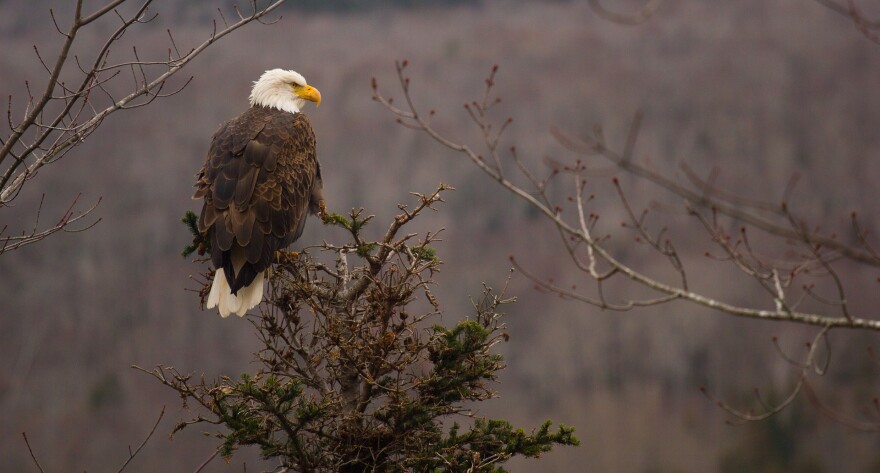Here is an old story and a new story. Unfortunately, both involve the death of some of our favorite birds because of complications resulting from aquatic invasive species.
Maybe you have heard about loons dying in Lake Michigan due to a tangled story about the lake’s food web. Lake Michigan has been hugely taken over by quagga mussels, a bivalve that by now covers almost the entire floor of Lake Michigan – nearly shore to shore. Like zebra mussels, the quaggas filter water, consuming all the phytoplankton, or floating algae out of the water. This clears up the water, so that light can penetrate deep into the lake. The quaggas release quite a bit of poop and so the very bottom of the lake is rich in nutrients. This encourages a bloom of Cladophora, an alga that likes to live on hard substrates like rocks (or quagga mussels) at the bottom of lakes. After the Cladophora dies, it uses up all the oxygen as it decomposes. In the oxygen-deprived environment, certain bacteria go to town, making a toxin that causes botulism. Bottom dwelling animals feast on the bacteria, along with the botulism toxin, and the toxin travels up the food web. Ironically, the most common fish down at the bottom of the lake is another invasive species, the round goby. The botulism toxin affects the gobies, making them easier to catch. Loons and other birds eat the easy-to-catch gobies, and the birds die from botulism poisoning. Since 1999, biologists estimate that 100,000 birds, including bald eagles, great blue herons, ducks, loons, terns and plovers have died in the Great Lakes because of these botulism outbreaks. Dan Egan, in his book The Death and Life of the Great Lakes, gives the full story.
Another tragic food web story about a lake has recently unfolded in Arkansas. About 25 years ago, bald eagles were suddenly, and mysteriously, dying by the dozens. Biologists noticed the eagles were having trouble flying; their wings drooped, and they sometimes flew straight into cliffs. Coots living on the same lakes were found trying to swim upside down, before they, too, died.
What was going on? Was it botulism, like with the loons in Lake Michigan? Or a pesticide, like DDT? Biologists started investigating the deaths, and right away they learned that the brains of the dead birds had big holes, or vacuoles. Only now, 25 years later and with scientists working from around the world do we now know the whole story. The lakes where the birds were dying were filled with an exotic invasive aquatic plant called Hydrilla, an invasive cousin of a common plant found in Wisconsin lakes called Elodea. Growing on this plant was a previously unknown cyanobacteria or blue-green algae. It has long been known that some cyanobacteria produce toxins, such as the toxin that can harm your pets if they drink water from a lake with a blue-green bloom. The scientists learned that this previously unknown cyanobacterium was the source of a previously unknown neurotoxin that was damaging the birds’ brains and causing their deaths. However, the toxin was not produced unless the cyanobacteria had grown on the Hydrilla, and only if grown on Hydrilla in certain lakes. Eventually, they discovered that the neurotoxin was lethal if it had incorporated five bromine atoms into its molecular structure. Bromine is an element, but it is rare in the natural environment, so where had it come from, and why was it only found only in certain lakes? The Hydrilla, the invasive plant, had become such a nuisance that lake managers were treating the lakes with an herbicide, called diquat dibromide. Yes - the herbicide used to kill the aquatic plant was the source of the bromine and was in the water and the sediments where the Hydrilla had been treated. But how did the eagles get this toxin? The eagles don’t eat aquatic vegetation, but coots do. The toxin bioaccumulates in fats and in the tissues and traveled up the food chain. The coots ate the Hydrilla with the bromine-laden cyanobacterial toxin and became neurologically impaired. The coots became easy prey for the eagles, the eagles ate the coots and the eagles died.
So, the mechanism is not the same in these two sad stories, but there are clearly common threads. The first is the complex problems caused by invasive species introduced into our waters. The second is the dangerous toxins created by bacteria in these altered ecosystems. Invasive species are a huge problem, and there are no easy answers. But if someone tries to tell you their new pesticide is a magic bullet for your particular invasive species, ask questions, be cautious, and remember the complicated story of eagles brought down by a few bromine atoms.







